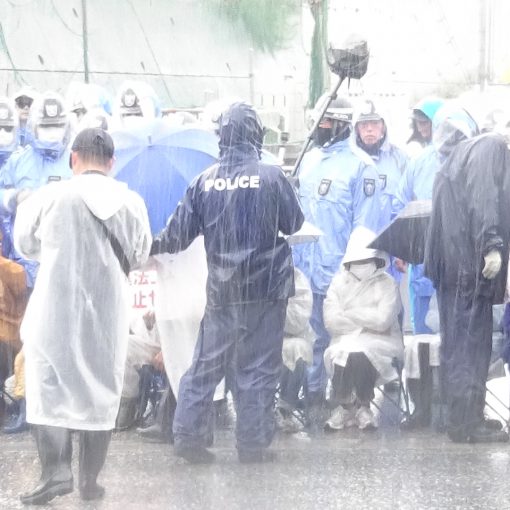The Okinawa Defense Bureau developed a new method to speed up the unloading of earth and sand. The Committee on Environmental Monitoring, initiated by the government, presented it on Nov 17.
Previously, landfill soil was transported onto a dike from one ship at a time. The new method sets up a large pontoon of 60 by 20 meters at the end of a dike to moor carrier vessels, enabling two vessels to unload simultaneously at the K9 seawall. Only one cargo ship continues to unload as before at the K8 seawall, yet, now a more massive ship can moor at the K8. Furthermore, they discuss the feasibility of mooring a large vessel of 141 by 36 meters stationary in Oura Bay to store landfill soil.
The changes will increase air pollution, but the Committee sees no problems and proceeds on firming up the new method.
They have so far dumped slightly less than 3.5% of the total amount required to complete the landfill. Provided that two years equals about 4%, they will complete the construction well beyond 13 years from now, the scheduled time of completion. Even if they hasten the landfill at the Henoko side, the Oura Bay side’s soft ground remains to be improved. Hastening the landfill work at the side of Henoko will not affect the overall schedule for completion.
Nevertheless, Prime Minister Yoshihide Suga insists on “visible” construction work. His intention to give the impression that the construction of the new military base proceeds and is going well is visible to us.

(In front of Camp Schwab Gate)
With a temperature of 29 degrees Celsius and under the bright sun, about 40 people participated persistently in the sit-in protest. The women, holding a microphone one after another, sang and made the rally alive and bearable.
When the gate opened, and after the dump trucks entered inside the base grounds, the demonstrators paraded shouting messages, “The sea does not need concrete!” “The Defense Bureau! Do not violate the people’s will!”
Ms. S from Tokyo, who visited Henoko for the first time, said, “I wanted to witness the protest. The elderly risk their health to resist hard against the government’s guards who violently defend the administration that pushes the construction forward. It brought tears to my eyes. I genuinely believe something is wrong with the current administration.”
A total of 213 trucks delivered the earth and sand.


(Ryukyu Cement Awa Pier)
About 30 members of Nambu Shimagurumi (The Southern chapter of the Island-Wide Conference) protested at the pier’s entrance and exit. Riot police gathered around the exit gate and tried to stop the protest rally. Aggressive arguments repeatedly went on between the protesters demanding to walk crisscross the exit road and the commander H trying to let the trucks go through. He stopped the protesters crossing the road for over 20 minutes even when no trucks were coming out of the exit gate. The protesters shouted, “Excessive control!” and “No traffic rules favor vehicles over pedestrians!”
Only a few officers attended the entrance and could not move the traffic smoothly. About 40 trucks jammed the road before the entrance.



(Motobu Shiokawa Pier)
As there were no empty vessels available, no construction work was done.
Number of dump trucks to date and percentage against the total
The estimation calculated on the basis of the number of ruckloads serves only as a reference.
Number of dump trucks which made delivery from December 2018 to the end of December 2019 114,601(1.39%)
| 14(Sat) | 16(Mon) | 17(Tue) | 18(Wed) | 19 (Thu) | 20(Fri) | |
| Awa | 0 | 950 | 1150 | 415 | ||
| Shiokawa | 0 | 518 | 260 | 0 |
| Number of dump trucks ※ |
Weightt of earth/sand
※① |
Converted to volume
※② |
Volume per Total
※③ |
| 280,208 | 1,401,040t | 700,520㎥ | 3.468% |
※ Cumulative since Dec. 1, 2019
※① Calculated by assuming that the average truckload per dump truck would be 5 tons
※② Calculated by assuming that a specific weight of soil/sand set to be 2
※③ Percentage against 20.200.000m3, the total volume of earth and sand required for the landfill.





